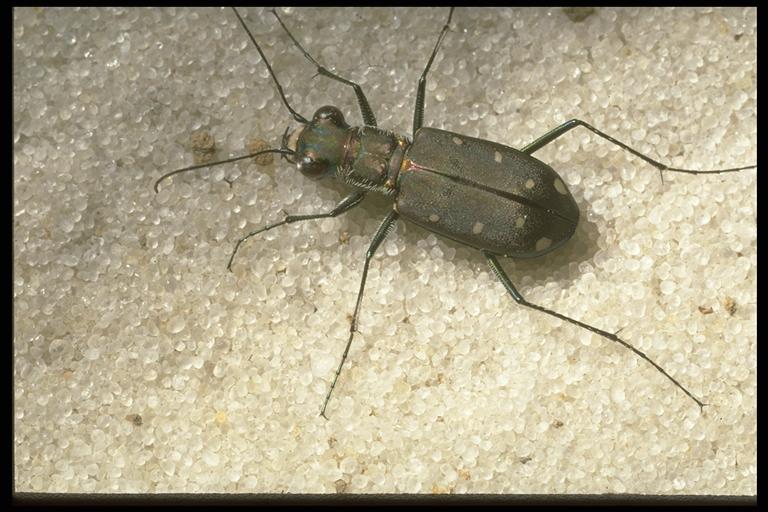
Tiger beetle, Cicindela ocellata rectilatera Chaudoir (Coleoptera: Cicindelidae). Photo by Drees.
Common Name: Tiger beetle
Scientific Name: Cicindela ocellata rectilatera Chaudoir
Order: Coleoptera
Description: Adult beetles are about 1/2- inch long and have long antennae and legs. They differ from ground beetles in that the head is wider than the thorax. Common species are grayish brown to black with white spots and markings on the wing covers (elytra), although they may show considerable variation in coloration and markings. Some species have metallic or iridescent blue, green and bronze coloration. Adults of species are identified by distinguishing characters that include presence of hairs on the face of the head as well as the pattern and texture of the wing covers. Tiger beetles are closely related to ground beetles.
Life Cycle: Adults and partially developed larvae overwinter deep in the soil in burrows. Eggs are laid in individual burrows by females. Larvae hatching from eggs dig burrows in the soil that they enlarge as they develop through three larval stages (instars). Burrows may be over a foot deep in hard-packed sand. Larvae are flat-headed with powerful jaws and S-shaped with recurved hooks on their fifth abdominal segments that they use to anchor themselves in burrows in the soil.
Habitat and Food Source(s): Mouthparts are for chewing with sickle-like mandibles. Most tiger beetles are active during sunny days and are frequently seen in sandy areas such as along the shores of rivers and streams, resting on the surface and then running or flying quickly away when approached. Some are active at dusk or are nocturnal. Larvae live in burrows in the soil where the wait for passing prey like a trap with open sickle-like jaws. Both adult and larval stages of tiger beetles feed on a wide variety of insects and are generally considered to be beneficial. Some species are attracted to lights, and some give off an odor when handled. Larvae may be collected by feeding a long grass stem down the burrow, then digging down until the larva is found. It may help to sift the soil to separate the larvae.
Pest Status: Active during the day; adult and larvae stages are predaceous on other insects; Cicindelidae, which are occasionally included in the ground beetle family, Carabidae; larvae and adults can bite if handled improperly.
Management: None, this is a beneficial insect.
For additional information, contact your local Texas A&M AgriLife Extension Service agent or search for other state Extension offices.
Literature: Frank & Slosser 1991; Swan & Papp 1972.